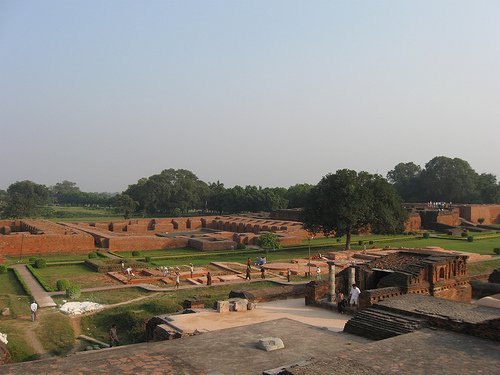

Location: Nalanda District Map
Open: daily
Museum: Sat- Thu
Nalanda an ancient Archeological site situated in Nalanda District in India, 88 km South East of Patna. Nalanda Archaeological Site was an important commercial and religious center starting with the 5th century AD during reign of Sakraditya (ruler identified as Kumara Gupta I or Kumara Gupta II) and lasted until 1193 when it was sacked by a Turk ruler Bakhtiyar Khilju. In his attempt to wipe out Buddhism from region he burned many Buddhist monasteries and many of the monks. Nalanda did not entirely cease its existence. A small community of Buddhist monks still lived among ruins of the former city, but it went in significant decline from that point on and was eventually abandoned.
The university was founded in the first third of the
5th century. Nalanda flourished during the reign of the Gupta dynasty;
the Pala rulers who replaced the Guptas continued to patronize this
establishment.
The famous Chinese Buddhist scholar and traveler
Xuanzang of the 6th century wrote about Nalanda. A thousand professors
taught there, ten thousand students studied there, the university owned
nine-story buildings, 6 temples and 7 monasteries, and the library
stored 9 million books. According to Xuanzang, the university had an
early version of entrance examinations: those who arrived to participate
in discussions were asked difficult questions by gatekeepers, so that
those who could not answer were given up the idea of entering.
In
1193, the university was destroyed as a result of the invasion of the
Turkic invading army led by the Muslim fanatic Bakhtiyar Khilji, who
spread Islam by force of arms. Thousands of monks were burned alive or
beheaded, and the richest library of Nalanda was burned. This event
dealt a great blow to Buddhism in India, which then fell into decline.
Many Buddhist monks fled to Nepal and Tibet to escape persecution.
In 1351, a training center under the same name opened in Tibet.
In the 9th-12th centuries, thanks to the activities of teachers from
Nalanda, the Tibetan Buddhist tradition was formed. Thanks to the
efforts of the Nalanda philosophers, the Madhyamaka and Yogacara
doctrines were formulated in the form in which they were later
transmitted to Tibet.
Nalanda University housed workshops for
copying books, as well as workshops for the production of Buddhist
painting and bronze sculpture. In all likelihood, Vajrayana canons for
the depiction of Buddhist deities were developed in Nalanda, which were
later transferred to the art of Nepal and Tibet along with the monks who
fled from the Islamic iconoclasts.
Partially preserved ruins
remain on the site of the university. A modern Theravada center is
located nearby. The excavated archaeological zone covers an area of
about 150,000 m², but a significant part of the excavations has not yet
been carried out. The nearby museum houses manuscripts discovered during
excavations.
Since 2006, the efforts of Buddhists in India and
other countries have been planning to revive Nalanda University under
the name Nalanda International University.
On September 1, 2014,
the first classes were held at the modern Nalanda International
University in the nearby town of Rajgir with the participation of 15
students.
The monastery is mentioned as the source of the
traditions of currently operating monasteries.
Some modern
Buddhist organizations are named after Nalanda, such as the Nalanda
Monastery in France.
In 1915 the first archaeological remains were
discovered and excavations began which only ended in 1985, showing the
ancient splendor of Nālandā to the world.
The structure extends
over 450 meters and is 220 meters wide and is characterized by a main
entrance in the north, eight monasteries in the east and stupa monuments
and temples in the western part. The main material used for the
construction of the structure is fired brick. The <<Main Temple>> has
been rebuilt seven times, maintaining the square-plan structure over the
centuries, and is embellished with Buddha and Bodhisattva stupas.
The monastic complex, built of bricks (quarried stones sometimes
served as filling material), included 9-story buildings and numerous
temples and monasteries in its heyday. The library is said to have
contained 9 million books. It was therefore the largest teaching center
of the ancient world.